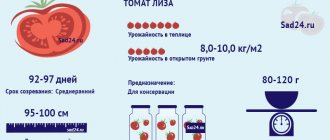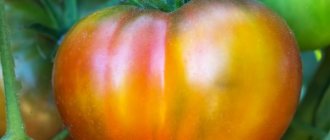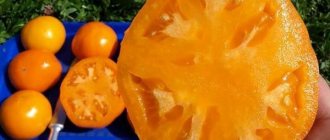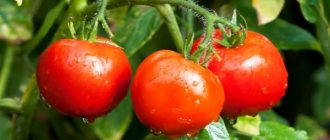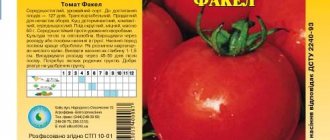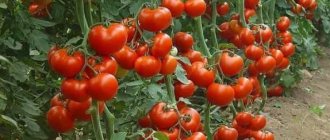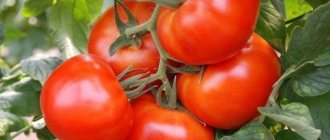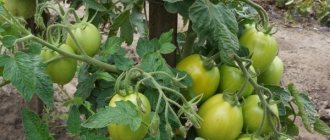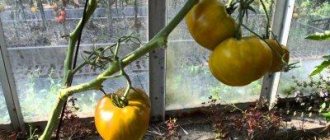Tomatoes with orange fruits are no less popular than pink ones. Especially when we are talking about such an unpretentious variety as the Nepasynkuyu orange heart-shaped. The bushes do not require pinching; the fruits bear well both in hot and cool weather.
| Height | Landing location | Ripening time | Fruit color | Fruit size | Origin | Fruit shape |
| short | Greenhouse, Open ground | Early ripening | Orange | Average | Variety | Heart-shaped |
Tomato Bullish Heart, Coeur de boeuf
Medium late variety (fruits are formed on the 120-130th day after emergence) originally of Italian selection. Today, there are many adapted forms and hybrid analogues of the F1 tomato Bull's Heart in many countries of the world - in Russia, France, Germany, etc.
The plant is powerful, spreading, with few leaves. The bushes are tall, not standard, of a determinate type, and require tying to a support.
The average yield per bush is 3.5-5 kg of tomatoes when grown in open ground and 8-12 kg in greenhouse conditions.
The fruits are large and very large (300-500 g, sometimes up to 1000 g!), fleshy, irregular in shape (in the vast majority of cases, heart-shaped). The upper fruits are much smaller than those that grow on the lower tiers of the bush. The color of the skin and pulp - depending on the variety - is red, pink, lemon, white-yellow, “black”.
The peel is thin and easily separated from the pulp. The inside of the fruit is fleshy, dense, low in water, with a high content of dry matter and a sweet taste. There are practically no veins.
The fruits are characterized by good keeping quality and transportability.
Description of tomato variety Golden Heart and its characteristics
The Golden Heart tomato is the result of the work of Russian breeder Yu. I. Panchev. The variety, intended for cultivation in open ground, was registered in the State Register of the Russian Federation in 2001 and is recommended for homestead and small farms in all climatic regions. Of course, where tomatoes generally do not grow due to the cold climate, Golden Heart can only be grown in a greenhouse, but for greenhouse cultivation you can select more profitable varieties, the bushes of which grow up to the ceiling. The Golden Heart has a low bush, up to 70 cm, in greenhouses it is slightly higher. This is a typical early ripening determinate tomato. The first fruits ripen a little later than three months after full germination.
Despite the compactness of the bush, it must be tied up: the stems are rather frail
The leaves on the bushes of this tomato are small and of a regular green color. The fruits, collected in clusters of 5–7 copies, are heart-shaped with slightly noticeable ribs. When fully ripe, tomatoes become orange in color. They are of medium size: the weight of each fruit is about 100 g, which allows them to be used not only for salads, but also for whole-fruit canning. In the State Register, the purpose of fruits is indicated as universal. It is especially noted that the chemical composition of the fleshy pulp allows the use of tomatoes of this variety in dietary nutrition: they have a high content of beta-carotene, which is a natural antioxidant. The color, both outside and inside, resembles a ripe persimmon. The taste is described as sweetish and delicious.
There are 4 or more seed nests in the fruits, the number of seeds is small. Productivity is about 7 kg/m2. Fruiting is extended: continues until frost. The skin of the fruit is dense, allowing the harvest to be transported over considerable distances. Tomatoes store well, and those collected unripe, “arrive” successfully during storage.
Tomato Gnome Pink Passion (Dwarf Pink Passion, Pink Passion)
Mid-early variety (fruits are formed approximately on the 105th day after emergence) of American selection.
Plants are medium and low-growing (up to 1 m), require tying to a support and partial pinching. Can be grown as a standard. The leaves are wide and wrinkled.
Does not tolerate shading and requires nutritious soil. Productivity is high.
The fruits are medium-sized (weight up to 200 g), round-heart-shaped, ripen to a raspberry-pink color. The skin is thin, the flesh is fleshy, aromatic. The taste is well balanced, pleasant, sweet.
The fruits are characterized by good keeping quality and transportability.
Tomato Nepasynkuyuschiy orange heart-shaped (Nepas 4)
Mid-early variety (fruits are formed on the 100-105th day after emergence) of Russian selection.
The plant is low (up to 0.7 m), determinate, standard, does not require pinching.
The variety is resistant to various rots, unpretentious in cultivation, loves sunny places, but will tolerate even cold or dry weather.
Medium-yielding - 5-6 kg of fruits are consistently harvested from 1 sq.m.
The fruits are medium-sized (60-80 g), deep orange in color, elongated heart-shaped, slightly ribbed, and contain a lot of beta-carotene. The skin is thick, the flesh is very dense and sweet.
The fruits are characterized by good keeping quality and transportability.
Tomato Danko (Heart of Danko)
Medium late variety (fruits are formed on the 110-118th day after emergence) of Russian selection. Due to its popularity, various agricultural companies sell many of its analogues with similar names.
The plant is medium-sized (up to 0.8 m), determinate, compact, weakly leafy, requires tying to a support and pinching. The variety is undemanding to soil, unpretentious in cultivation, resistant to temperature changes, drought-resistant, and low susceptible to diseases and pests.
The yield is stable, the average is about 3-3.5 kg per bush (much higher in greenhouse conditions).
The fruits are medium and large in size (150-500 g), rich orange-red color, rounded heart-shaped, aligned. The skin is thin, the flesh is fleshy, of excellent taste.
The fruits ripen quickly (prone to cracking), but are not very well stored and transported.
Features of planting and growing tomato Golden Heart
The Golden Heart tomato in agricultural technology is a typical determinate variety of early ripening, with its pros and cons. Caring for it is no more difficult than most other varieties, but you should not expect a good harvest from uncultivated beds. Since not much time passes from the moment of sowing the seeds to the ripening of the first harvest, in the southern regions you can grow Golden Heart by direct sowing of seeds in the ground, which is usually done. In the middle zone, and even more so to the north, seedlings must be pre-grown.
Since the best seedlings are a little more than two months old, in most regions for growing tomatoes in open ground, seeds are sown in boxes at the end of March. For greenhouse cultivation, this can be done almost a month earlier. Sowing seeds and growing seedlings of tomatoes of this variety has no special features. If immediately after germination the boxes are not left warm and the seedlings are allowed to remain at a temperature of about 16 °C for 4–5 days, the seedlings will be unlikely to overgrow in the future.
If the conditions are met, seedlings are not in danger of overgrowing.
Planting in the garden is carried out when summer weather sets in. Golden Heart is a cold-resistant variety, but night temperatures below 8–10 ° C are very undesirable for planted seedlings. If heat lingers, the tomato bed should be covered with spunbond. The planting technique is usual; the density, despite the compactness of the bush, is no more than four plants per square meter: the Golden Heart has high nutritional requirements. In connection with this requirement, feeding must be carried out necessarily: in addition to the traditional three feedings (two weeks after planting, at the beginning of flowering and after fruit set), this variety is fed at least two more times (a week after the first feeding and two weeks after the traditional last ), using mainly organic fertilizers.
As for watering, the situation with the variety is as follows: it is quite drought-resistant, but in dry soil the development of the plant is suspended and the ripening of the crop is delayed. Therefore, in the first half of summer the soil should be constantly slightly moist. Tomatoes of this variety are not prone to cracking, but it is better to avoid excessive moisture during fruit ripening.
Usually the Golden Heart bush is formed into two stems, leaving the most powerful stepson under the first brush. You can leave two, but the rest, up to the first brush, should be broken off as they appear. The stepsons above the raceme are generally left; a crop is also formed on them, but if they continue to emerge after July, they are removed. Bushes without support are unstable, so tying them to pegs is necessary. All flowers that appear in August should be removed: the fruits from them are unlikely to have time to grow and ripen.
The formation of a bush is carried out according to the usual schemes
In many regions that are not the warmest, they do not wait for the tomatoes on the bushes to fully ripen; they pick them brown and allow them to ripen during storage. At the same time, if the taste deteriorates, it is only slightly, but the rest of the fruits have more nutrition and sun. Brown tomatoes ripen especially well if there are several fully ripened ones nearby.
Video: Golden Heart tomato fruits on the bushes
Tomato Heart-shaped white
Mid-early variety (fruits are formed approximately on the 100th day after germination) of Russian selection.
The plant is tall (up to 1.5-2 m), indeterminate, with powerful stems, needs staking. The variety is extremely resistant to adverse weather conditions (especially frost), and the fruits are not prone to cracking.
The fruits are large (200-500 g), heart-shaped, with a small number of seeds, white with noticeable yellowness. In the light “transparent” pulp, pink stains appear as it ripens. The pulp is tender, fleshy, aromatic, sweet.
The fruits are characterized by good keeping quality and transportability.
The best heart-shaped tomatoes
The first “heart” tomatoes were Pink and Red Bull's Heart; now the line of varieties has expanded significantly. Thanks to the work of breeders, you can choose options based on fruit color, taste and other characteristics. Let us describe the heart-shaped tomatoes that have received the most positive reviews from gardeners from different regions.
Attention! Most heart-shaped tomatoes have very fragile bushes and thin stems. Considering that the fruits are usually large, you cannot do without a high-quality garter. Indeterminate bushes should be grown in 2, maximum 3 stems.
For convenience, we will divide the varieties according to the color of the tomatoes.
Pink varieties
They differ from others in that they have a delicate taste, a pleasant pulp consistency, thin skin, and contain an increased amount of dry matter, sugars, and antioxidants. Gardeners often praise tomatoes such as Yasha Yugoslavian, Sensei, Fatima, Minusinsk pink, Cardio, Kosovo, Japanese, Mikado Sibiriko, African Liana. We will describe the best varieties in more detail:
- Ukrainian Miracle of the Earth. Mid-early tomato for open beds and greenhouses. The bush is indeterminate. Immunity to disease is excellent; in rainy weather there is a risk of cracking. Tomatoes from 350 grams to a kilogram, the first ones are the largest, then gradually become smaller. The taste is good, sweet, absolutely no acid, aroma with fruity notes. Productivity is high.
- Russian beauty. Approved for cultivation in all regions in open and closed ground, as well as under film covers. It ripens in the middle period, the bush is indeterminate. Productivity up to 9 kg/m². The plant is resistant to fusarium and tobacco mosaic virus. The tomatoes are dense, slightly ribbed, weighing from 160 to 380 grams. The taste is sweet without acid.
- Dad. An early ripening, indeterminate variety for cultivation in greenhouses and greenhouses. Immunity to disease is excellent. Tomatoes from 150 to 450 grams, slightly ribbed, medium density, fleshy. The taste is excellent, there is no acid. Productivity up to 3 kg/m².
Red varieties
Traditional red tomatoes most often have a sour taste, weak or pronounced. They have less lycopene content than pink ones. To begin with, let's list the varieties and hybrids that 80% of summer residents like: Bulgarian and Belarusian Heart, Cone, Walford's Miracle, Andijan, Inseparable Hearts. Now let's move on to describing the best varieties:
- Vater Rein. Mid-season, semi-determinate (up to 1.5 meters) tomato for greenhouses. Tomatoes with an elongated nose weigh from 350 to 700 grams, sometimes up to a kilogram, fleshy, sweet, dense. Productivity is high, immunity to infections and pests is good.
- Budenovka. Designed for greenhouses, film shelters, planting in exhaust gas is possible only in the south. The ripening period is mid-early, the bush is indeterminate. The fruits are heavily ribbed, ranging from 150 to 400 grams. The taste is rich, balanced, pleasant. Productivity is about 9.5 kg/m².
- Kangaroo heart. Mid-season, indeterminate variety for open ground and greenhouses. The plant is unpretentious, resistant to negative weather factors, diseases, and pests. Productivity up to 14 kg/m². The tomatoes are fleshy, dense, have a dessert, sweetish taste.
On a note! The Kangaroo Heart tomato is one of the best for making lecho, juices, ketchups, pastes and adjika.
Black varieties
Tomatoes with black, blue, brown, chocolate and purple fruits are considered the healthiest. They have a harmonious sugar-acid index and a very rich taste, but if grown improperly they can be watery and insipid. Among the heart-shaped varieties, Mikado black and Bull's heart black stand out, but the following deserve special attention:
- Brad's black heart. Indeterminate, mid-season tomato for greenhouses and open beds. It can be cultivated in Siberia and the Urals. The tomatoes are burgundy-black with a purple tint; the stalk has a greenish spot, from which beautiful strokes extend to the middle of the fruit. Productivity is high (especially in a greenhouse), immunity to disease is increased. Tomatoes 200–500 grams, sweet.
- Cherokee purple heart-shaped. Mid-season, productive, indeterminate tomato for open and closed ground. Immunity to diseases is good. The fruits are dense, violet-purple, juicy, fleshy, and have an excellent taste. Average weight 350 grams.
- Purple Strawberry. Indeterminate, productive variety, ripening in medium terms, resistant to diseases, prone to cracking. Planting in open beds is possible only in regions with early spring and warm, long summers. The fruits are ribbed, pinkish-purple, sweet, juicy, fleshy, weighing from 250 to 400 grams.
A selection of black varieties of tomatoesBlack tomatoes are aromatic, the pulp contains a high concentration of the coloring pigment anthocyanin. Scientists have proven it...
Yellow and orange tomatoes
These varieties attract with their brightness and incredibly delicate taste, often with fruity notes. These tomatoes are considered leaders in sugar content; if acid prevails, it means that the rules of agricultural technology have not been followed. Varieties that deserve attention include Yellow Bun, Orange Berry, Yellow Scallops, and Golden Domes. Other varieties and hybrids occupy leading positions:
- Orange German strawberry. An early-ripening, indeterminate tomato with good immunity to major tomato diseases and adverse weather conditions. The taste is very sweet and fruity. The fruits are not dry, fleshy, practically without grains, from 220 to 750 grams. Productivity is consistently high.
- Liskin Nose (Orange Heart). Tall, early ripening tomato with a short shelf life. The fruits are fleshy, juicy, 180–450 grams, and very tasty. Productivity is about 6 kg/m², resistance to adverse weather conditions is excellent, and resistance to diseases is average.
- Nizami. It ripens in medium terms, the bushes are indeterminate, in the Moscow region it is recommended to grow it in a film or polycarbonate greenhouse; the variety is not suitable for the Urals, Siberia, Leningrad. Tomatoes are dense, fleshy, sweet, from 150 to 430 grams. The pulp has an oily consistency and there are almost no seeds. Productivity up to 10 kg/m², increased immunity to disease.
Tomato varieties with several shades
Gardeners pay a lot of attention to heart-shaped bicolor tomatoes. The main feature of these tomatoes is their unusual color (several shades, blurry or brightly outlined). Most popular: Love Heart, Canadian Heritage or Canada, Sergeant Pepper, Everett's Rusted Heart. The following varieties and hybrids received the highest ratings:
- Orange Russian 117. Mid-season, indeterminate tomato, recommended for greenhouses and open ground. Immunity to diseases is weak. Fruits from 150 to 300 grams, fleshy, juicy. The fruits are light orange with pink streaks and strokes, the nose is painted scarlet. Productivity is about 6 kg/m².
- Crushed heart. A tall, mid-season tomato, in warm regions it can be grown without shelter, in the middle zone and in cool regions only in a greenhouse. Tomatoes from 150 to 450 grams, fleshy, sweet. The color is dark pink, the skin is decorated with golden stripes over the entire surface. Productivity is high.
- Pineapple Heart. Mid-season, indeterminate variety, resistant to diseases and cracking. The fruits are 280–600 grams, fleshy, spicy-sweet without acid. The color of the skin is uniform, chocolate, the flesh in cross-section is bicolor, the middle is burgundy, and closer to the walls it is orange-light green.
Abakan pink tomato
Medium late variety (fruits are formed on the 110-120th day after emergence) of Russian selection.
The plant is of a determinate type, grows up to 0.7-0.8 m in height (in a greenhouse much higher, up to 1.5 m), needs shaping and tying up. The variety is unpretentious in cultivation, resistant to temperature changes, frost-resistant, and low susceptible to diseases and pests.
Medium-yielding - 5-6 kg of fruits are consistently harvested from 1 sq.m. Fruiting is extended over time.
The fruits are medium and large in size (about 250-350 g, can grow to more than 500 g), pink-raspberry color, heart-shaped, with tasty, fleshy pulp of medium density. The taste is sweet, rich with delicate sourness.
The fruits are characterized by good keeping quality and excellent transportability.
How to grow and care for the Ox Heart tomato
Since the variety has a long growing season, it must be grown using seedlings. The ideal age of seedlings for planting in a permanent place is two months after the seedlings have sprouted.
Planting seeds
Before sowing the seeds, they must be doused with boiling water. This process will destroy all fungi present on the surface. If you purchased seeds in a store, you don’t have to go through this process; the seeds have already undergone all the necessary procedures. Next, disinfect the soil in which you are going to sow the seeds. In the prepared soil, make holes no deeper than two centimeters and drop one or two grains into it. Make sure that the size between the holes does not exceed two centimeters. Place the container with the sown seeds in a dark but warm place, after covering it with glass or film. As soon as the first shoots hatch, remove the lid and place the container in the sun. As soon as the seedlings have two or three true leaves, the plants should be transplanted into separate cups. Every six months, seedlings need feeding; in this case, summer residents use fortified, mineral fertilizers for seedlings. Before you start transplanting your seedlings to their permanent growing location, remember, a few weeks before, start hardening them off. Place the seedlings on the balcony, street, or simply open the window for two hours. Gradually increase the time.
How to transplant seedlings into a greenhouse
When the seedlings reach 20 centimeters in height, they should be transferred to the greenhouse and planted. The optimal time for transplantation is mid-April. The greenhouse should be warm and light. When planting plants in a permanent place, keep in mind that they are no closer than a meter to each other. To do this, you need to dig holes 20 centimeters deep and add humus to each. As soon as the seedlings are in the hole, they must be thoroughly watered with cold water.
How to care for seedlings in a greenhouse
During the day, the air temperature in the greenhouse should not fall below 22 degrees and should not be below 18 at night. Water the seedlings as the soil dries out. For every square meter, about seven liters of liquid are needed. As soon as the fruits begin to form, the volume of liquid per bush should be increased to 15 liters per square meter. Be sure to ventilate the greenhouse, tomatoes should be pollinated independently, be sure to shape the plant, tie it up and get rid of the stepsons. Fertilize the soil every six months.
Tomato German Red Strawberry
Mid-season variety (fruits are formed on the 100-115th day after emergence) of German selection.
Plants are medium and tall (up to 1.6 m), semi-determinate, need shaping and staking. The variety is unpretentious in cultivation, highly resistant to diseases and pests.
The yield is very high - up to 8 kg per bush (about 15 kg per sq.m. in open ground and more than 20 kg in greenhouse conditions).
The fruits are raspberry-red in color (there is an orange variety), heart-shaped, medium and large in size (200-500 g), fleshy. The skin is thin but durable, the flesh is uniform in color, with a small number of seeds. The taste is bright, sweet, with a slightly noticeable sourness.
The fruits are characterized by good keeping quality and excellent transportability.
